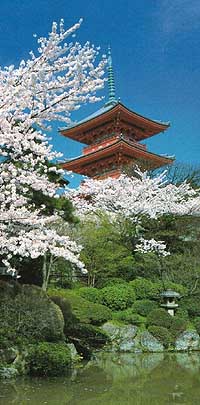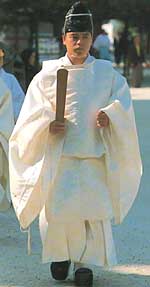by Chalerm Raksanti
Japan is a small country. With an area of 145,800
square miles, Japan is smaller than California and larger than Germany.
However, its islands extend nearly 2,000 miles from north to south,
comparable to the distance from the Canadian border to the tip of the
American state of Florida. This geographic spread gives Japan a climatic
diversity unmatched in countries of comparable size.
 The
three story pagoda of Kiyomizudera in Kyoto, a temple complex first
established in 798, is dedicated to Kannon, the Buddhist diet of
compassion.
The
three story pagoda of Kiyomizudera in Kyoto, a temple complex first
established in 798, is dedicated to Kannon, the Buddhist diet of
compassion.
Although their precise origins remain unclear, the
Japanese have developed a rich and diverse culture that is clearly a blend
of East Asian, Polynesian, and now Western influences. It is true that the
Japanese, for the most part, are ethnically and linguistically homogenous.
But there is also great geographical and climatic diversity. The twin
barriers of mountains and seas have divided the country into distinct
regions with different lifestyles, foods, dialects and craft traditions.
The geological account of the formation of the Japanese
islands is interesting and violent. In geological terms they have not long
been islands, but at one time formed a mountain range on the eastern rim
of the Asian continent, joined at the north to Siberia and at the south by
Korea, and the Sea of Japan, a huge inland lake.
 Overseeing
the various rites in a Shinto shrine is the kan-nushi, or priest.
Overseeing
the various rites in a Shinto shrine is the kan-nushi, or priest.
Up-thrusting mountains and subsiding sea beds separated
this range from the mainland and the individual islands from each other,
perhaps 20,000 years ago. This cataclysmic geological rearrangement
attests to Japan’s precarious location on what is termed the Pacific Rim
of Fire, a line of intense seismic activity that circles the Pacific
Ocean. Japan has more than 40 active volcanoes, and several hundred more
have been active in recent history. No one is more aware than the Japanese
of the fragility of the cool crust that covers our earth’s molten
interior. Natural thermal springs abound and scores of tourist spots
feature bubbling pools or jets of steam shooting from the ground.
Earthquakes, from minor tremors to prolonged, window shattering shakes are
common occurrences. Nearly a tenth of the energy in the world each year is
concentrated in or around Japan.
Located in the temperate monsoon zone, Japan is also
strongly influenced by seasonal weather patterns. In winter, cold winds
blow off the Asian continent, dropping heavy snowfalls on the Sea of Japan
side of the islands. The Pacific coastal side, protected by the high
central mountains, enjoys clear skies and moderate temperatures. Summer
brings warm winds from the South Pacific, and typhoons, especially to the
southern regions of the country.
 The
“wedded rocks” at Ise
The
“wedded rocks” at Ise
These geographical and environmental factors played a
large part in shaping the society, culture and beliefs of the Japanese
people. The desirability and necessity of harmony with nature permeated
every aspect of Japanese life, and these attitudes are clearly manifested
in the rituals and beliefs of the indigenous religion of Shinto, which
literally means “the way of the gods”. Shinto reflects the existence
of kami, those deities resident in almost every unusual or prominent
natural feature such as mountains, rivers, even large trees and rocks.
These spirits must be appeased through offerings of rice and sake and
entertained with dances and festivals. Shinto reveres fertility and
purity, both closely associated with water, a recourse with which Japan is
abundantly blessed.
Flowing mountain streams symbolize the flow of man’s
existence, and the power of water to bring life to the rice paddies is
apparent. The ocean, identified as the source of life also provides food.
The warm Japan Current and the cold Okhotsk Current meet off the coast of
Japan, creating extremely fertile fishing grounds.
 During
a freezing winter in Hokkaido a fisherwoman strips a net of walleye
destined for use in fish cakes.
During
a freezing winter in Hokkaido a fisherwoman strips a net of walleye
destined for use in fish cakes.
Since antiquity, the Japanese have stood in awe of
nature, personified in the kami associated with the natural aspects of the
land and sea. Insuring harmony between the powers of the gods and ordinary
mortals required the proper seasonal rituals of purification and
thanksgiving.
Devine status is not always easy to determine by
visitors as a journey through Japan will surely reveal. A grotto on the
rugged coastline or a simple mountain steam can be a blessed place or
represent a part of mythical lore. Mount Fuji is the most beloved symbol
of Japan and sacred to both Buddhist and Shinto adherents. Meotoiwa, the
“wedded rocks” near Ise are joined by a rope and symbolize the male
and female deities Izanagi, the mythical creators of Japan. According to
the story, these two gods stood upon the Floating Bridge of Heaven and
dipped a jeweled spear into the ocean that covered the world below. Brine
dripping from the spear created an island onto which the gods descended
and made love. Their offspring became all the other major islands of the
archipelago which makes up the nation. Not scientific, but very romantic.

 The
three story pagoda of Kiyomizudera in Kyoto, a temple complex first
established in 798, is dedicated to Kannon, the Buddhist diet of
compassion.
The
three story pagoda of Kiyomizudera in Kyoto, a temple complex first
established in 798, is dedicated to Kannon, the Buddhist diet of
compassion. Overseeing
the various rites in a Shinto shrine is the kan-nushi, or priest.
Overseeing
the various rites in a Shinto shrine is the kan-nushi, or priest. The
“wedded rocks” at Ise
The
“wedded rocks” at Ise During
a freezing winter in Hokkaido a fisherwoman strips a net of walleye
destined for use in fish cakes.
During
a freezing winter in Hokkaido a fisherwoman strips a net of walleye
destined for use in fish cakes.

